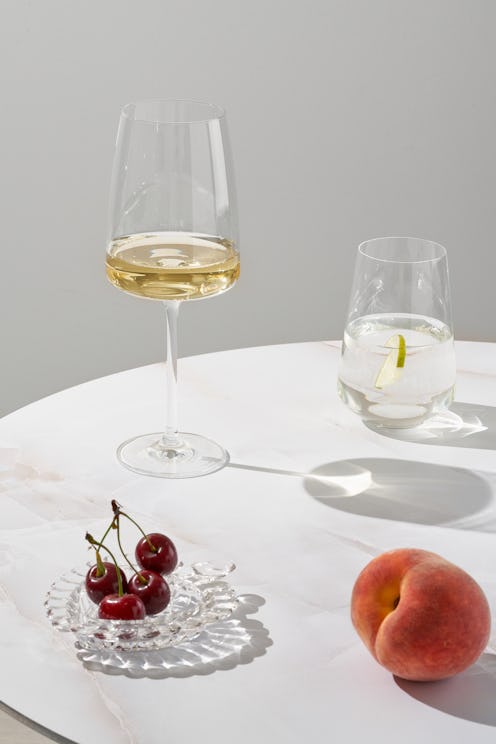(Entertaining)
Wine Blends Are Trending Big For Summer
Variety is truly the spice of life.

Variety is the spice of life and even a beloved beverage like wine can use a little shake-up now and then. That’s where wine blends come in. Think of wine blends like a cocktail — but in this case instead of different types of ingredients coming together to create a concoction, two similar ingredients (grape varietals) marry to create a luscious libation.
Whenever you see a wine and the label denotes the style of wine like Bordeaux, Rhône, or Soave instead of the grape used like Pinot Noir or Sauvignon Blanc, chances are it’s a wine blend. Red and white blends are the most buzzed about but also extend to rosé, orange, and sparkling varietals. So why do wine blends exist? What makes them special, and what do they taste like?
Cody Hurd, winemaker at Priest Ranch breaks down wine blends in layman’s terms. “A wine blend is any wine that has more than one individually fermented component,” he says. Hurd notes that wine blends have a multitude of variations. “Cross-varietal blending is very common. Cross-vintage blending is less common but is done sometimes. Cross-appellation blending is very common. For example, a wine labeled ‘California’ may have fruit in that blend from all over the state. Whereas a wine labeled as ‘Napa Valley,’ must be from Napa Valley.”
When winemakers go through the arduous process to ensure that every year, each varietal they produce is of top quality and displays distinct flavors, why would they mess with perfection and create blends? “The simplest reason for winemakers to make blends is to make wine taste better,” Hurd explains. “Every vineyard and individual varietal have its unique attributes. Blending helps to bring the final wine into balance.”
Hurd points out that there is a history of which grapes are best for certain blends and the majority of blending still follows these historical trends. “The trends are there for a reason. They typically make great wines. This is a good starting point, but every vintage, appellation, estate, or even individual site within an estate produces different traits. The decision of what grapes to blend together can change every year.”
Amy Racine, beverage director of JF Restaurants, sheds more light on how and why certain blends are created. “Winemakers look for characteristics they like in different varieties. One might have desirable floral notes, one might have acidity, and one might have a body or texture they want,” she shares. Racine compares the final product of a wine blend to a composed sauce or dish whose many components create a harmonious delicacy.
A wine blend is also a way for winemakers and vineyards to produce signature wines, which benefits the business and wine drinkers. “In many cases, a blend reflects the winemaker or house style, more than a single variety that expresses the terroir.” She continues, “For wine lovers, the world of blends can create a fun and endless opportunity to taste through producers and find your favorite style because no two are the same.”
Andrea Felluga, owner and winemaker at Livio Felluga, expounds upon Racine’s sentiment, adding that blends are particularly exciting for oenophiles, “well-versed in the profile of a specific grape who want to taste something new,” or for “someone who wants to experience the character of a terroir or region, and its expression through the lens of a talented winemaker.”
Regardless of whether the blend is red, white, or rosé, Racine explains that all wine blends are made one of two ways. “Post-fermentation blends are grapes that are fermented separately (made into wine on their own) and blended,” she says. “The second is a co-ferment when the different varieties are fermented together.”
Hurd points out that while these techniques are used to blend wines all over the world, the blends differ depending on where they’re produced. “The rules of blending change from region to region, but most regions do blend wines in one way or another. Many common blends originated in certain regions of the world. For example, a left bank Bordeaux style blend would typically be Cabernet Sauvignon dominant, with some Merlot, Malbec, Petit Verdot, and Cabernet Franc. Another classic example is a blend of Grenache, Syrah, and Mourvedre, which is a Rhône blend.”
Wine Blends Rules Of Thumb
Navigating the wine aisle can be intimidating enough to newcomers when trying to pick out well-known varietals like Chardonnay or Merlot, so our experts have some tips to help demystify the blended world. Hurd’s first tip is to do some homework.
“I always recommend that people research exactly how to read wine labels,” he says. “This might sound simple, but there are many intricate rules in the United States and in individual AVAs that apply to how wine is labeled. Label knowledge really helps wine drinkers understand exactly what they are drinking.”
Lastly, Hurd suggests a good starting point for choosing a wine blend is exploring a different blend of a wine you already like that includes those varietals. “Someone might learn that, while they love Petite Sirah, it might be a little too tannic for them as an everyday drinker. Well, let’s find some Petite Sirah/Zinfandel/Syrah blends,” he advises.
Ahead, expert-approved picks that celebrate the art of blending and create a unique tasting experience for both wine lovers and casual sippers.